15 Best Things To Do In Dubrovnik, Croatia (Updated With 2 More)
Foreword by your authors
The Pearl of the Adriatic. Misho and I had knew tales of its beauty, but nothing could prepare us for the magic that awaited us. We had just arrived and decided to walk the ancient city walls, hoping to catch the sunset over the Adriatic Sea.
As we strolled, we stumbled upon a hidden alcove that offered a perfect view of the old town’s terracotta rooftops. We decided to sit and enjoy a bottle of local wine we’d picked up earlier. Just as we were toasting to our adventures, a mischievous seagull swooped down, snatching Misho’s favorite hat right off his head! We watched in astonishment as it perched on a nearby turret, flaunting its prize.
A local musician, witnessing our predicament, began strumming a playful tune on his guitar, singing about the thieving seagull and Misho’s beloved hat. The surrounding tourists joined in the laughter, and soon, we were all singing along, creating an impromptu street performance.
Though Misho never got his hat back, that evening in Dubrovnik gifted us a story we’d recount for years. The city, with its charming quirks and warm-hearted locals, had etched a special place in our hearts.
Quick Intro
Explore Dubrovnik’s Old Town

What is it?
Dubrovnik Old Town is a UNESCO World Heritage Site. This ancient and historic walled city sits on the Adriatic Sea and is renowned for its stunning architecture, including its impressive city walls, cobblestone streets, beautiful churches, and monasteries. The Old Town of Dubrovnik was recognized over centuries for its beauty, culture, and importance to the country`s history.
The best tour to experience the old town is this one here.
The original Dubrovnik City Walls date back to the 13th century, making them one of the most important medieval fortifications in Europe. These walls line the entire circumference of the old town and are an incredible sight to behold, standing around 1 km long with towers at strategic positions along their length.
Brief history
It has a rich history dating back to the 7th century. Its iconic city walls were constructed between the 13th and 17th centuries and are still preserved. As one of the most famous tourist attractions in the country, Dubrovnik’s Old Town is filled with stories from bygone eras.
The city’s first settlers are believed to have arrived during the 1st century AD when Greek sailors founded a settlement near the harbor. The city was officially established as a Republic in 1358, after being granted its own constitution by King Louis I of Hungary.
Throughout its long history, Dubrovnik had close ties with influential figures such as William Shakespeare, who referenced it in his play “Twelfth Night”.
2 Fun Facts About Dubrovnik`s Old Town
- It was ruled by the Byzantines, Venetians, and Ottomans before becoming part of Yugoslavia in 1918.
- Even with all these changes, its unique Baroque architecture was well-preserved over time.
Lokrum Island
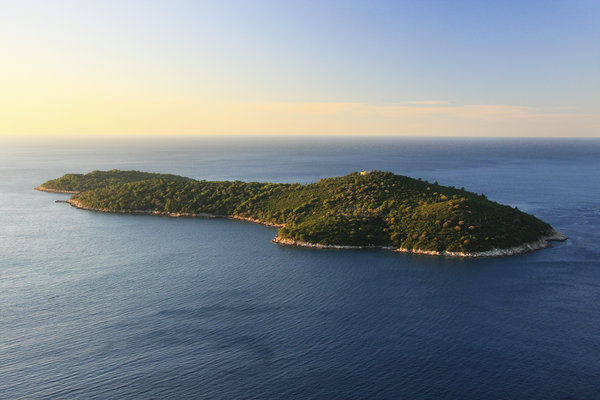
What is it?
Measuring just 0.8 square miles, Lokrum is the perfect size for visitors who want to take advantage of its many activities and attractions without feeling overwhelmed.
The island’s unique environment includes lush vegetation, rugged cliffs, and crystal clear waters that make it perfect for swimming, snorkeling, or simply taking in breathtaking views from one of its numerous scenic spots. Here’s the best tour for experiencing Lokrum.
There are also several historical sites on Lokrum such as a Benedictine Monastery which dates back to 1023 AD and Fort Royal—built by Napoleon Bonaparte during his occupation of Dubrovnik in 1806–07—that provide insight into the area’s interesting past.
Brief history
In the 15th century, Lokrum Island served as the summer residence for the rulers of the Republic of Ragusa (now Dubrovnik). Over time, it became a tranquil oasis for locals and visitors alike who were seeking relief from life’s everyday pressures.
In 1808, Napoleon Bonaparte took possession of Lokrum Island after he seized control over Ragusa. He used it as a base from which he could launch naval attacks against Venice and Austria.
2 Fun Facts About Lokrum Island
- This idyllic escape was inhabited since the 10th century and is now a popular destination for tourists worldwide.
- It has one of the best-preserved fortresses in Europe and provides great views of Dubrovnik from its vantage point on the island’s highest point.
Lovrijenac Fortress
Ul. od Tabakarije 29, 20000, Dubrovnik, Croatia || from Monday to Sunday 9 AM – 3 PM
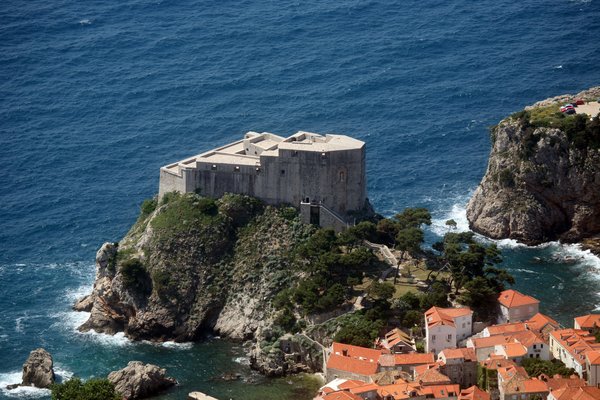
What is it?
Lovrijenac is an iconic landmark that is steeped in centuries of history. Built-in 1301 to protect against Ottoman invaders, Lovrijenac witnessed many famous battles and sieges throughout its long lifetime. It stands as a testament to the resilience of those who lived there for generations.
The imposing 37-meter-tall fortress stands on a rocky outcrop just outside the city walls of the city and offers stunning views across the sea. Accessible only by foot or boat, visitors can explore its many towers and courtyards filled with artifacts from different periods in its history.
Brief history
Built directly on the Adriatic Sea, Lovrijenac was an important part of the city’s history. The Republic of Ragusa first constructed the fort as a method of defense against Venice and other foreign powers. Throughout its time as a stronghold, Lovrijenac withstood numerous sieges, attacks, and occupations – cementing its place in the country`s history.
The fort’s most impressive feat occurred during the Venetian siege of 1463-1479 when it held out for five years despite being surrounded and outnumbered by enemy forces. The Venetians eventually retreated due to the heavy losses they suffered while attempting to breach the walls of Lovrijenac.
2 Fun Facts About Lovrijenac
- The Lovrijenac Fortress was built in only three months!
- It was constructed by local residents of Dubrovnik in order to protect the city from Venetian invasions in the 12th century.
Go on a Game of Thrones tour
What is it?
Game of Thrones fans rejoice! This city is the home to some of the most iconic filming locations from the hit HBO series. The city became one of the most sought-after destinations for Game of Thrones enthusiasts looking to get a firsthand look at Westeros.
Now, visitors can explore these famous sites with a guided tour that takes them through all the must-see spots in one day.
The Game of Thrones Tour begins bright and early in Dubrovnik’s Old Town, where many scenes from King’s Landing were filmed. Visitors will learn about how this historic city was transformed into Westeros while standing in front of several well-known filming locations.
Next, they’ll be taken to nearby Fort Lovrijenac and Trsteno Arboretum before heading back to Old Town for lunch.
Brief history
The beautiful city of Dubrovnik was for a long time a tourist destination due to its stunning architecture, breathtaking views, and rich history. But in recent years, it became even more popular among fans of the hit show Game of Thrones due to its use as a filming location.
For those looking to immerse themselves in Westeros and explore the real-life history behind this fantasy world, there is no better way than taking a Game of Thrones tour of Dubrovnik.
On these tours, visitors will be able to walk through some of the most iconic shooting locations from the show and gain insight into how they were used within the story.
2 fun facts about the Game of thrones tour
- Most of King’s Landing is actually filmed in and around Dubrovnik.
- The exterior shots were captured in and around the Old Town of Dubrovnik while interior scenes, such as those at the Red Keep or Great Sept of Baelor, were filmed on soundstages in Belfast.
Pile Gate
Walls of Dubrovnik, 20000, Dubrovnik, Croatia || every day open 24 hours
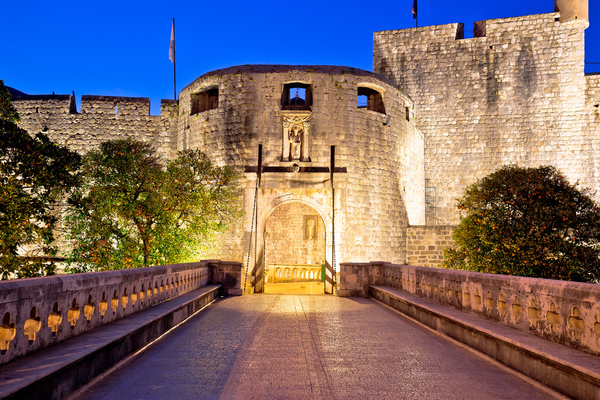
What is it?
Pile Gate in Dubrovnik is a spectacularly preserved and iconic landmark of this ancient city. Located at the entrance to the old town, Pile Gate is one of only two entrances that lead into the walled city.
As you enter through this historic gate, you can feel a sense of awe as you take in its grandeur. Here’s the sunset tour to take you to Pile and all the walls.
The design of Pile Gate is impressive, with two towers connected by an archway, which was built to defend against invaders during medieval times. Visitors can walk through the gates and admire their intricately carved sculptures along with statues dedicated to St Blaise, Dubrovnik’s patron saint.
The stone walls surrounding Pile Gate add to their majestic appearance and it’s easy to understand why they stood for hundreds of years.
Brief history
Pile Gate is one of the most recognizable landmarks in this city. It was once a major trading port for merchants from all over Europe and beyond. As time passed, however, Pile Gate became an important symbol of Dubrovnik’s history and culture. Built in 1537, its sturdy walls withstood wars and natural disasters for centuries.
The towers are decorated with three crests – one from Dubrovnik itself, one from Ragusa (the former name of Dubrovnik), and another from King Louis I of Hungary and Croatia – that signify the long history of this coastal town.
2 fun facts about Pile Gate
- Pile Gate was originally constructed as a defensive wall to protect Dubrovnik from attackers.
- Over time, it served multiple functions – from hosting events to welcoming visitors into the city. In fact, it even served as a chapel for religious ceremonies!
Stradun
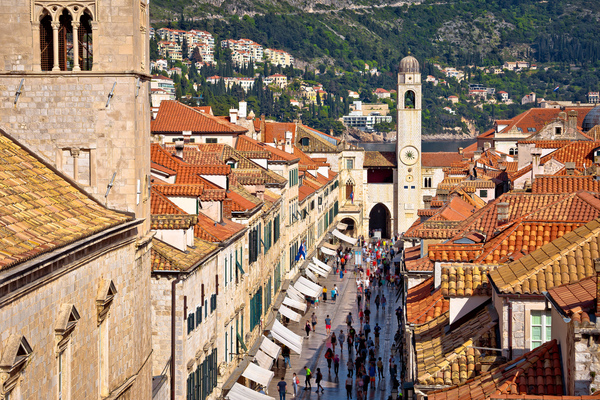
What is it?
Stradun, or Placa as it is also known, is the main street of this city. This stunningly beautiful cobblestone street runs for over 300 meters and was a major part of the city’s history since its establishment in the 13th century. It is one of the most notable landmarks in Dubrovnik and serves as a major tourist attraction. Here’s a tour to explore Stradun.
Stradun links two main squares in Dubrovnik: Onofrio’s Fountain Square at one end and Orlando’s Column Square at the other.
Along Stradun are several churches including St Blaise Church, Franciscan Monastery, Dominican Monastery, and Sponza Palace. Additionally, there are many cafés and restaurants along this area of town where visitors can enjoy the traditional cuisine of the country or simply people watch from an outdoor terrace table.
Brief history
Stradun, the city’s main street, is a stunning example of the city’s long and storied history.
Originally established as a trading town on the Adriatic Sea in 890 AD, Dubrovnik was under Roman rule, had ties to Venice, and was ultimately declared an independent Republic in 1358. Over the years Stradun served as a marketplace for local goods such as fruits, vegetables, seafood, and crafts from around the country.
2 fun facts about Stradun
- First and foremost, it’s worth noting that this street was built entirely out of white limestone which helps give it a unique look when compared to other cities in the country.
- The stone also helps reflect light during both day and night for a stunning effect.
Botanical Garden
What is it?
The Botanical Garden in Dubrovnik is one of the most beautiful gardens in the country, located near the city center. Visitors can explore this lush paradise filled with an incredible variety of trees, plants, and flowers from all over the world.
The garden covers an area of six hectares and is highly appreciated for its unique botanical collection, which includes rare species such as Japanese maple, Chinese magnolia, or Australian eucalyptus.
The garden also features a number of fountains and ponds along with amazing sculptures all around the grounds. In addition to its extensive flora, Botanical Garden Dubrovnik also hosts various educational events that relate to planting life throughout the year.
Brief History
The Botanical Garden Dubrovnik is one of the oldest and most historic botanical gardens in Europe. It was first established in 1831 by a committee of local citizens and scientists. For over two centuries, the garden was an integral part of Dubrovnik’s history and culture.
The garden started with just a few hundred plants from the region. Over time, more species were added from around the world, creating an impressive collection for visitors to explore today. Highlights include rare Mediterranean flora as well as a stunning array of orchids, palms, succulents, and desert plants.
2 fun facts about Botanical Garden
- The Botanical Garden of Dubrovnik spans three hectares and contains over 3200 species of plants, including rare varieties like Silver Lime trees and Judas Trees that are native to the country.
- In addition, there are several greenhouses on site that feature collections from countries such as Cuba, Mexico, Chile, South Africa, and Australia. You can also find historic medicinal herbs gathered from various parts of Europe!
St. Jakov Beach
Ul. Vlaha Bukovca 14, 20000, Croatia || from Monday to Sunday 7 AM – 6 PM

What is it?
St. Jakov Beach in this city is an idyllic location for those looking to relax and soak up the sun. This stunning beach offers a variety of activities for visitors of all ages to enjoy. With its white sand beaches and breathtaking views, St. Jakov Beach has something special to offer to everyone who visits.
This beach is wonderfully serene, with plenty of opportunities for swimming and snorkeling and boat trips across the sea or kayaking along the shoreline.
The scenery is simply spectacular; here, you can admire picturesque views of Dubrovnik’s Old Town and its surrounding islands from the comfort of your sun lounger! In addition, you can also find some amazing restaurants and cafes in close proximity which add even more charm to this wonderful destination.
Brief history
St. Jakov Beach is one of the most serene and picturesque beaches in all of Europe. This beach has a long and fascinating history that goes back hundreds of years. Located on the outskirts of Dubrovnik, this beach was once the home to a fishing village and was known primarily as “Little Bay” until the 19th century.
The first written record of St. Jakov Beach dates back to 1813 when it was mentioned as a place suitable for bathing due to its crystal clear waters and beautiful surroundings. Over time, this area grew into a popular tourist destination with many people coming to enjoy its stunning views and quiet atmosphere. Today, St. Jakov Beach remains one of the top destinations for visitors looking for some peace and relaxation along the country’s Adriatic coast.
3 fun facts about St. Jakov beach
- The beach lies within a national park called Lokrum Island which is known for its rich flora and fauna.
- This area also provides various activities such as snorkeling and kayaking, allowing visitors to explore its underwater beauty.
- The beach also has an interesting history; it was once used as a landing point during the Yugoslav Wars in 1991-1995 when refugees were coming into safety from the conflict zones in Bosnia and Herzegovina.
Franciscan church and monastery
Poljana Paska Miličevića 4, 20000, Dubrovnik, Croatia || every day 9 AM – 6 PM

What is it?
The Franciscan Church and Monastery is a stunning historical landmark located in the heart of the city. The church was standing since 1252 when it was first built as a place of worship for Franciscans. For centuries, it served as a sanctuary for people looking to connect with their faith and spiritual beliefs.
Visitors can explore the stunningly preserved Romanesque architecture and enjoy its many works of art from various periods.
The interior of the monastery is just as awe-inspiring as its exterior, featuring incredible frescoes from 1317, intricate stone carvings, and an exquisite domed ceiling that reaches up to 16 meters high. This magnificent space is also home to two chapels: one dedicated to Our Lady of Angels and another dedicated to St Anthony Abbot.
Brief history
The Franciscan Church and Monastery of Dubrovnik are iconic destinations for religious pilgrims and tourists alike. The two sites have a long history that stretches back to the 13th century. The church was erected by Franciscan friars in 1360, making it one of the oldest Franciscan monasteries in Europe.
As a center of spirituality and culture, the monastery was home to some renowned works over its 800-year history. These include several altarpieces that were created during the Baroque period as well as a large collection of religious artifacts from across Europe.
In addition to these works, visitors can also explore other areas such as a library containing over 30,000 volumes, or take part in Masses held in Latin at the main chapel.
3 fun facts about Franciscan church and monastery
- Firstly, the Franciscan Church and Monastery was built on the site of an even older Romanesque church which dates back to 1225.
- Secondly, it houses a collection of over 10,000 books in its library – something that is unique among other churches in Dubrovnik and even Croatia!
- This makes it part of one of Croatia’s oldest religious complexes.
Take A Ride On The Cable Car
Ul. Kralja Petra Krešimira IV. 10A, 20000, Dubrovnik, Croatia || every day 9 AM – 4 PM
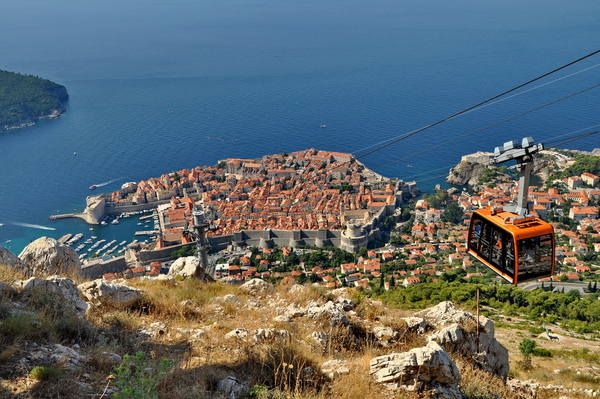
What is it?
The cable car is a unique and exciting way to experience the city.
The journey begins at the base station located near the city walls and takes visitors up to Mount Srdj, located 418 meters above sea level.
From this high vantage point, one can take in breathtaking panoramic views of the Adriatic Sea and Old Town below.
Brief history
This iconic cable car system was running since 1969, taking locals and tourists alike up to the stunning Mount Srđ for unparalleled views of the city.
Although it was closed for some time due to conflict in the early 1990s, it was restored to its full glory and is now one of Dubrovnik’s most popular attractions.
The original construction of the cable car began in 1968, with engineers from Austria helping to install and construct this remarkable feat of engineering.
It took just a year before it was opened and ready for use on May 1st, 1969; an impressive achievement considering the steep incline that needed traversing!
2 fun facts about the Cable car
- The cable car is approximately 1.5 km long, making it one of the longest aerial tramways in Europe.
- The ride offers stunning views along the way, allowing passengers to take in all that Dubrovnik has to offer from above.
City Walls
every day 9 AM- 3 PM
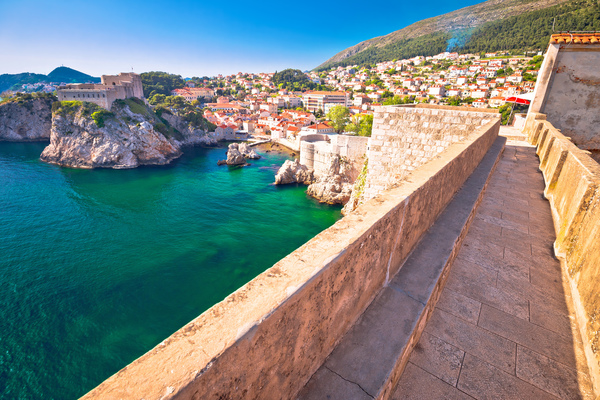
What is it?
The city walls of Dubrovnik, are a must-see for anyone visiting the area. These walls were standing since the Middle Ages and are still in remarkable condition today. They were designed to protect the city from invaders, but now they serve as a symbol of its resilience and long history.
Stretching nearly two kilometers around the old town, these incredible walls provide visitors with breathtaking views of the Adriatic Sea and the surrounding landscape.
The seven entrances allow visitors to explore different parts of this impressive structure, which includes several towers and bastions that offer even more amazing vistas.
Visitors can also take a guided tour to learn about the history behind these incredible fortifications, including how it was able to withstand multiple sieges over many centuries.
Brief history
The construction of Dubrovnik’s fortification system began in the 9th century when it was known as Ragusa.
The Venetians expanded the defensive walls during their rule over Ragusa between 1205 to 1358. In 1573-1808, under the rule of the Republic of Ragusa (later known as Dubrovnik), further enhancements were made to strengthen their defenses against Ottoman forces from Turkey.
3 fun facts about the City walls
- Did you know that at over 6,000 feet long and 25 feet high, Dubrovnik’s city walls you can see from up to four miles away?
- Built with limestone and various other materials, it took the citizens of Dubrovnik almost 500 years to complete its construction.
- There are four entrances into the walled city: Ploce Gate in the east, Pile Gate in the west, Buza Gate near Lovrijenac Fortress, and St John’s Fortress in Srd Hill.
Dubrovnik Cathedral
Ul. kneza Damjana Jude 1, 20000, Dubrovnik, Croatia || every day open 24 hours
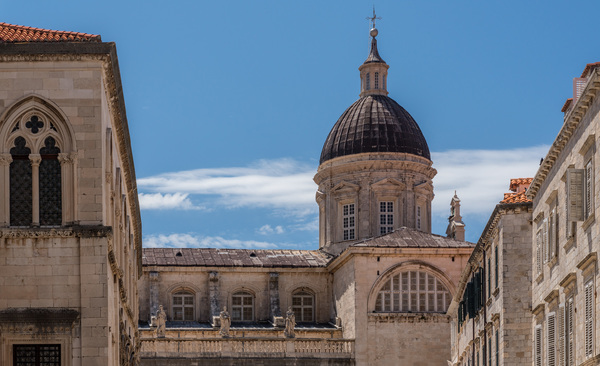
What is it?
Dubrovnik Cathedral, located in the stunning walled city of Dubrovnik, Croatia, is an incredible example of Baroque-style architecture.
This magnificent cathedral stands as a reminder of the city’s rich cultural and religious history. The majestic white stone façade is both eye-catching and captivating; it displays ornate sculptures of saints, angels, and other figures at its entrance.
Inside the cathedral are many remarkable works of art including several paintings by Italian painters such as Andrea Vaccaro and Paolo Veneziano. Its breathtaking interior also features several imposing marble columns that reach up to the impressive dome which soars high above visitors’ heads.
The grandiose atmosphere inside is made complete with a beautiful organ that was installed in 1866 along with intricately carved stalls for choir members to sit in while singing during Mass.
Brief history
Dubrovnik Cathedral has a long and illustrious history. The original Dubrovnik Cathedral was built in the 12th century on the ruins of an ancient Roman temple and was dedicated to Saint Blaise.
Over time, the cathedral underwent several renovations and expansions, including a major reconstruction in 1713 which included a new bell tower, sacristy, choir loft, and interior decorations.
3 fun facts about Dubrovnik cathedral
- The exterior walls of the cathedral were constructed with limestone from nearby islands that were shipped in by boat.
- The inside of the church is adorned with typical baroque-style paintings and sculptures that truly make it one of a kind.
- As if that wasn’t enough, there are also two spectacular bells located in the bell tower which were cast in 1715 – making them almost 300 years old!
Šunj beach on Lopud island
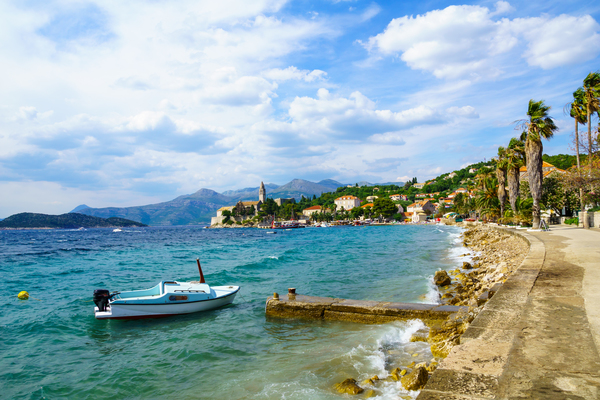
What is it?
Sunj Beach on Lopud Island is an idyllic spot to spend a day or two.
Located off the coast of Croatia, this tranquil beach has crystal clear waters and pristine white sand that provide a stunning backdrop for relaxation and fun.
Sunj Beach is the perfect place to get away from the hustle and bustle of everyday life.
The beach is ideal for swimming, sunbathing, and snorkeling as well as other activities such as volleyball and kayaking.
There are plenty of chairs, umbrellas, and loungers available so visitors can take in all that Sunj has to offer. Visitors can also explore the nearby caves, which are teeming with colorful Mediterranean fish.
For those looking for a little more adventure, there are plenty of trails for hiking around the island that offers breathtaking views of Lopud’s lush countryside.
Brief history
The history of Sunj beach dates back to the 15th century when it was first discovered by Venetian sailors. It quickly became a favorite spot amongst locals and travelers alike who came here to experience its tranquility and take advantage of the many activities available such as swimming, fishing, sailing, walking, and more.
Over time more amenities were added including restaurants and beach bars as well as boat rentals so visitors could easily explore nearby islands.
1 fun fact about Sunj beach on Lopud island
- The entire island is car-free and can be explored easily by foot or bicycle. This makes it easy for visitors to enjoy the natural beauty around them without worrying about traffic congestion.
The Dominican Monastery
20222, Lopud, Croatia || open every day 24 hours
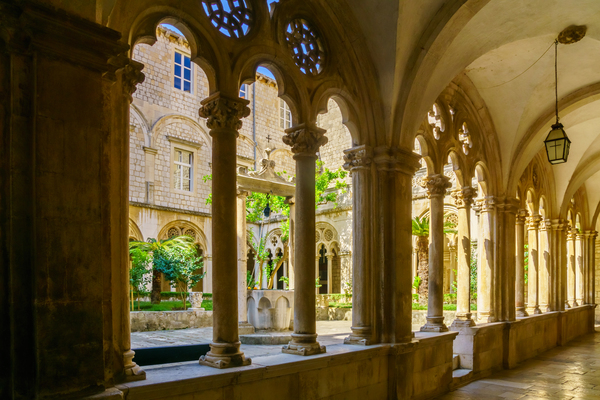
What is it?
The Dominican Monastery Dubrovnik is a treasured piece of Croatian history and a testament to the city’s religious background.
Located in Luža Square, this 14th-century monastery was preserved as an integral part of the city’s culture. The monastery houses several unique artifacts such as paintings, sculptures, and manuscripts that provide insight into the city’s past.
Its impressive architecture is made up of a main nave flanked by two towers, with an open cloister and an extensive courtyard filled with greenery. Visitors can explore the interior where they will find stunning painted altars and intricate stone carvings throughout.
Besides its spiritual significance, there are many cultural events held here including concerts, lectures, film screenings, and workshops that celebrate the historical heritage of Dubrovnik.
Brief history
The Dominican Monastery is a stunning example of Gothic-Renaissance architecture.
Built in 1225 as part of the Franciscan Order, this historic monastery was home to generations of monks and visitors alike for over seven centuries.
It was originally used as a stopover for pilgrims travelling between the Holy Land and Europe. Its unique design makes it one of the most recognizable landmarks in the city today.
The main building was constructed with four wings arranged around a central courtyard with an impressive cloister walkway around it. Inside, visitors can admire its beautifully decorated chapels and courtyards filled with original artworks from various Renaissance periods.
3 fun Facts About The Dominican Monastery
- Built between 1225 and 1431, this Gothic-Renaissance structure is a true testament to medieval architecture.
- It still stands as one of the best examples of gothic style today. Additionally, it contains many priceless artifacts that were collected over its long history. Most notable among these are several 15th-century paintings by renowned Croatian painter Andrija Alešić.
- The monastery also contains a library with thousands of books which were collected since its founding in 1225.
The Museum of Modern Art Dubrovnik
Ul. Frana Supila 23, 20000, Dubrovnik, Croatia || Monday closed from Tuesday to Sunday 9 AM – 8 PM
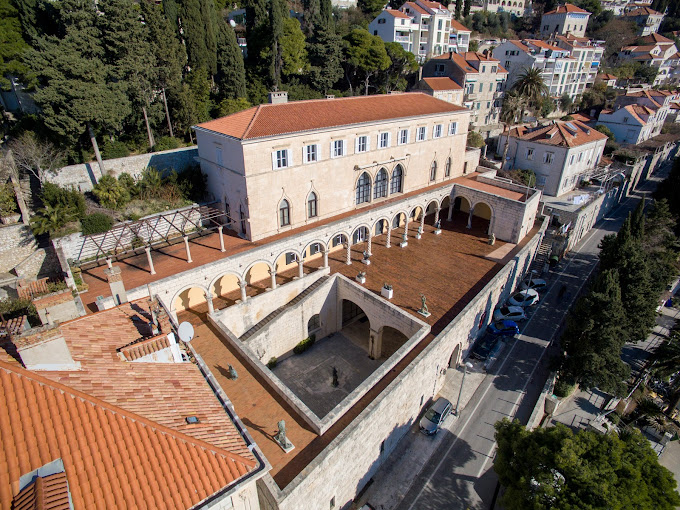
What is it?
The Museum of Modern Art Dubrovnik is an exciting and innovative art museum.
It opened its doors to the public in 2004, aiming to serve as a platform for modern artists and art enthusiasts alike. The museum’s expansive collection is comprised of both Croatian and international works from the 20th century onward.
Visitors will find a variety of media on display, including paintings, sculptures, photography, installations, prints, and drawings.
Additionally, the museum hosts temporary exhibitions featuring both established and emerging artists from around the world. Notable exhibitions include works by Picasso, Mondrian, and Warhol.
With its impressive array of artwork coupled with its engaging events such as lectures, workshops, and guided tours – the Museum of Modern Art Dubrovnik offers something for everyone!
Brief history
The MMAD features both Croatian and international artists, exhibiting their works in an interactive environment that encourages creativity and collaboration between visitors.
It also offers educational programs for children, adults, and families with a focus on modern art history and appreciation.
The museum also hosts special exhibitions throughout the year featuring established as well as emerging artists from around the world. Through its various programs, it strives to provide creative experiences that will cultivate cultural appreciation among its visitors.
3 fun facts about the Museum of Modern art Dubrovnik
- First, the museum was opened in 1975 by a group of local artists to showcase their work and celebrate modern art from around the world.
- Today, it features more than 2,000 works from over 500 different artists. The museum also houses several galleries featuring contemporary Croatian art as well as pieces ranging all the way back to antiquity.
- Additionally, visitors can take part in guided tours of both permanent and temporary exhibitions or attend lectures and other educational events held at the museum throughout the year.
Mljet Island
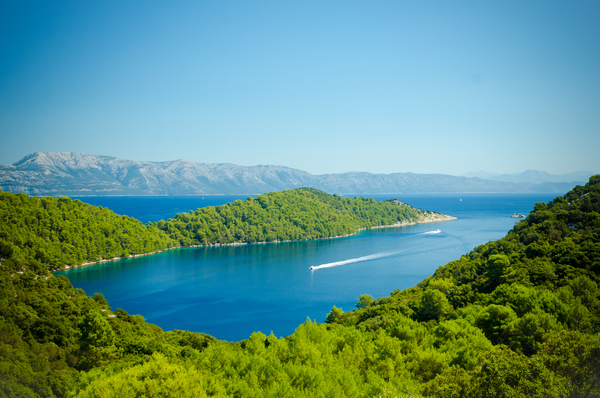
What is it?
Mljet Island in Dubrovnik is a stunning destination that should not be missed!
This island is located off the coast of Dubrovnik and offers an idyllic escape from the hustle and bustle of everyday life.
From crystal blue waters to lush green forests, Mljet Island has something for everyone to explore.
The natural beauty of Mljet Island is unmatched.
Boasting two saltwater lakes, incredible wildlife, and a variety of hiking trails, visitors can enjoy a unique experience when visiting this tranquil island oasis. Whether you’re looking for some rest and relaxation or an adventure-filled excursion, Mljet Island in Dubrovnik has something to offer everyone; it’s simply breathtaking! Here’s a tour to fully experience Mljet.
Brief history
It is known for its, vast array of cultural sites. In fact, this small island has a rich history that dates back to ancient times.
The earliest traces of human life on Mljet Island can be traced all the way back to the Bronze Age in 3000 BCE.
From then until the 6th century CE, it was occupied by Illyrians, who were eventually replaced by Greeks and Romans. During this time, Mljet served as an important port along trade routes between Greece and Rome.
The island was also influential during Medieval times when Dubrovnik became an independent city-state in the 12th century. Under Dubrovnik’s rule, Mljet flourished with churches and monasteries being built around the island’s beautiful lakes.
3 fun facts about Mljet island
- It’s said that Ulysses spent seven years living on this island in Homer’s Odyssey.
- The island is rich with history and culture; archaeological evidence suggests that inhabitants lived here as far back as the 5th century BC.
- Mljet Island is home to two saltwater lakes: Veliko Jezero (Big Lake), and Malo Jezero (Small Lake).
The open-air market in Dubrovnik Old Town
Gundiliceva Poljana, Dubrovnik
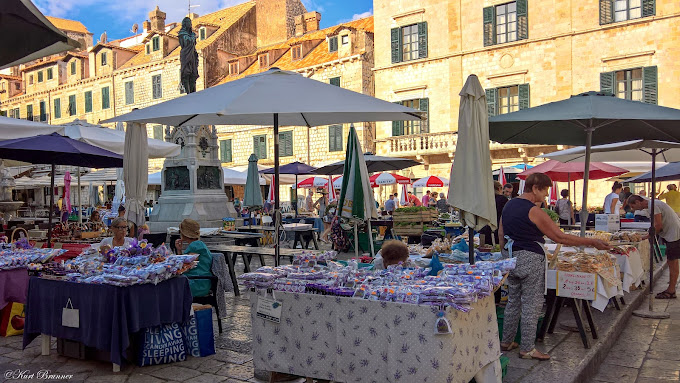
What is it?
This city has a long history of outdoor markets, with the open-air market in the old town being no exception.
This bustling and colorful marketplace offers visitors a unique opportunity to experience both local culture and cuisine first-hand.
From fresh fruits and vegetables to handmade crafts and souvenirs, this is an exciting destination for anyone looking to explore the heart of the city.
A visit to the open-air market begins with passing through one of the many entrances into this lively square from Stradun and other streets within Old Town.
Once inside, travelers will find themselves surrounded by vendors selling an abundance of goods from food items like olives, cheeses, and spices, to clothing items like traditional lace garments or jewelry made from pearls.
Brief history
The Open Air Market in Dubrovnik Old Town has stood for centuries, serving as a commercial hub for the city.
Established in the 1400s and based on an ancient Roman forum, it was considered a symbol of Dubrovnik’s prosperity and political autonomy.
Today, this colorful market is a vibrant center of activity that continues to thrive throughout the year.
The market also hosts weekly events such as concerts and special cultural activities like puppet shows or cooking classes. Guests may find themselves surrounded by locals dancing to traditional songs while they shop with delight!
3 fun facts about the Open-air market Old town Dubrovnik
- The market dates all the way back to 1317 when it was founded by merchants from Ragusa, an old name of Dubrovnik.
- It is divided into several smaller markets including Stradun (the main street), Siroka Ulica (wide street), and Gundulić Square. Many local farmers and artisans come here to sell their goods every day.
- The market also features many traditional restaurants where visitors can try some delicious Croatian dishes such as ćevapčići or pasticada.
While we traversed Dubrovnik, we came across alot of nomads that asked us a few questions about things to do here. So, we compiled all of them into this section below.
What are THE best things to do in Dubrovnik, Croatia?
The Best attractions include walking along the city walls, exploring the Old Town, taking a cable car ride for stunning views, visiting the Game of Thrones filming locations, and enjoying the crystal clear waters of the Adriatic Sea.
What are the must-visit attractions in Dubrovnik?
Some of the must-visit attractions in Dubrovnik include the historic Old Town, the ancient city walls, the charming streets of the old town, the beautiful Dubrovnik Cathedral, and the scenic Lokrum Island.
Is Dubrovnik worth a day trip?
Absolutely! Dubrovnik is definitely worth a day trip. Even if you have limited time, you can explore the main attractions, walk along the walls, visit a museum or two, and enjoy the vibrant atmosphere of this picturesque city.
What are some fun things to do in Dubrovnik?
There are plenty of fun things to do in Dubrovnik. You can take a kayak tour around the city walls, go on a Game of Thrones tour, try some local seafood delicacies, take a boat trip to nearby islands, or simply relax on one of the beautiful beaches.
Where should I stay in Dubrovnik?
The best place to stay in Dubrovnik is within the Old Town itself. You will be surrounded by historical sites, charming streets, and excellent restaurants. If you prefer a quieter atmosphere, you can also find great accommodation options in the Lapad area or on nearby islands.
Are there any day trips I can take from Dubrovnik?
Yes, there are several day trips you can take from Dubrovnik. Here are the best day trips:
What are some of the best views in Dubrovnik?
You can enjoy some of the best views in Dubrovnik by walking along the city walls, taking a cable car ride to Mount Srđ, visiting the Lovrijenac Fortress, or simply finding a rooftop terrace in the Old Town.
What are some of the popular Dubrovnik attractions?
Some of the popular attractions in Dubrovnik include the Dubrovnik City Walls, Fort Lovrijenac, the Dubrovnik Cable Car, Dubrovnik Cathedral, and the charming streets of the Old Town.
What should I know before visiting Dubrovnik?
Before visiting Dubrovnik, it’s good to know that it can get very crowded, especially during the summer months. It’s also important to wear comfortable shoes as there are many stairs and steep alleys in the Old Town. Finally, be prepared for some stunning photo opportunities, as Dubrovnik is incredibly picturesque.
Do you need travel insurance to visit Dubrovnik?
Whether you need travel insurance to visit Dubrovnik, which is in Croatia, depends on several factors.
1. Personal choice: This is entirely a personal decision based on your risk tolerance. If you can manage potential issues, such as trip cancellation, medical emergencies, or loss of personal belongings, without insurance, you may choose not to purchase it.
2. Country of residence: Depending on your home country’s health care agreement with Croatia, you might be covered for emergency medical situations, but this varies. Some countries have bilateral health agreements, while many do not.
3. Visa requirements: If you are required to get a visa to enter Croatia, travel insurance may be one of the requirements. Always check the most current requirements for visa applications, if applicable.
4. Your current health: If you have any ongoing health issues, it’s recommended to get travel insurance that covers medical emergencies and repatriation, since healthcare can be expensive and logistics complicated when far from home.
5. Duration and nature of your trip: If you plan to partake in high-risk activities (like extreme sports) or you will be staying for an extended period, travel insurance is advised.
6. Current global situations: In the context of situations like the COVID-19 pandemic, many airlines, countries, and even some accommodations may require proof of travel insurance that specifically covers COVID-19-related incidents.
Regardless of these factors, it is generally a good idea to have travel insurance to cover unexpected situations. However, specific requirements can depend on your circumstances, so it is always best to check with relevant authorities or your travel agent before your trip.
How To Get To Dubrovnik?
There are several ways to get to Dubrovnik, Croatia, depending on your point of origin:
1. By Air: The most common way to reach Dubrovnik is by flying into Dubrovnik Airport (DBV), also known as Ćilipi Airport. It’s the third busiest airport in Croatia and is served by many European airlines, especially during the summer months. From the airport, it’s about a 15-20 minute drive to the city center. Taxis, shuttles, and local buses are available to take you into town.
2. By Road: If you are already in Europe, you can drive to Dubrovnik. The city is well connected by road to other major Croatian cities such as Split and Zagreb, as well as cities in neighboring countries. Be aware that the most direct route from the northwest runs through a small corridor of Bosnian territory, so you may need to prepare for a border crossing.
3. By Sea: You can also reach Dubrovnik by ferry. Regular ferries operate between Dubrovnik and various Croatian islands, as well as the city of Bari in Italy. The city’s Gruž Harbor is the main port.
4. By Bus: Many bus companies operate services to Dubrovnik from cities in Croatia and other parts of Europe. The city’s main bus station is located in the Gruž area, about 2.5 kilometers from the Old Town.
5. By Train: Unlike many European cities, Dubrovnik does not have a train station, so it’s not possible to get there directly by train. The nearest train stations are in Split, Croatia, and Ploče, from which you can take a bus or a taxi to Dubrovnik.
Wrapping Up Things To Do In Dubrovnik
In conclusion, Dubrovnik is one of the most stunning and interesting cities in the Balkans.
Travellers are attracted to its unique and charming atmosphere, as well as its ancient walled city and beautiful Mediterranean scenery.
It’s a city that stood the test of time, withstanding war and preserving its culture throughout the years. Dubrovnik offers something for everyone, whether you’re looking for relaxation or adventure, making it an ideal travel destination.
The magnificent architecture, stunning coastline, and varied cuisine are just some of the many reasons why tourists flock to the city each year. It’s also an ideal destination for those looking to explore off-the-beaten-path locations and experience something truly special.
Are you traveling to Zagreb? Here’s our guide on the best things to do in the capital of Croatia.
Or maybe visiting Sarajevo? Enter the best things to do in Sarajevo.
Interested in Podgorica? Here’s the guide for that: https://direktorium.org/balkan-travel/things-to-do-in-podgorica-montenegro/

Avid travelers, passionate fishermen, and all-around great guys to hang out with (therefore the reason why they are the ones traveling around and not the rest of us, introverts and repulsive individuals). When not writing about their latest trip or catch, they drink beer, play the synth and call their friends to unpurposefully annoy them. A lot.